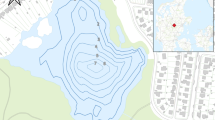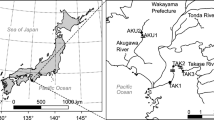Abstract
Stable isotopes (δ13C and δ15N) and gut contents were analysed for two species of co-occurring native and exotic fish in three shallow water bodies within an Australian riparian wetland system. During a period of hydrologic recession we found depletions in δ13C of up to −25‰ for algae and −2‰ for sediment organic matter (SOM). The native Hypseleotris sp. (carp gudgeon) and the exotic Cyprinus carpio (common carp) were depleted in δ13C up to −3.2‰, indicating that the SOM was the dominant dietary source of carbon for the two species of fish in both high- and the receded low-water conditions. In the low-water conditions, however, there was a five-fold increase in the occurrence of insects in the gut of the exotic C. carpio and the trophic positions of C. carpio and Hypseleotris sp. were more similar in all three water bodies than at high-water conditions. Our results indicate that there were shifts in dietary sources and trophic positions during hydrologic recession and provide evidence that flow reductions in wetland systems can increase the dietary overlap between native and exotic fishes.



Similar content being viewed by others
References
Arthington AH, Pusey BJ (2003) Flow restoration and protection in Australian rivers. River Research and Applications 19:377–395
Balcombe SR, Bunn SE, Davies PM, McKenzie-Smith FJ (2005) Variability of fish diets between dry and flood periods in an arid zone floodplain river. Journal of Fish Biology 67:1552–1567
Bunn SE, Arthington AH (2002) Basic principles and ecological consequences of altered flow regimes for aquatic biodiversity. Environmental Management 30:492–507
Bunn SE, Loneragan NR, Kempster MA (1995) Effects of acid washing on stable isotope ratios of C and N in penaeid shrimp and seagrass: implications for food-web studies using multiple stable isotopes. Limnology and Oceanography 40:622–625
Bunn SE, Davies PM, Winning M (2003) Sources of organic carbon supporting the food web of an arid zone floodplain river. Freshwater Biology 48:619–635
DeNiro MJ, Epstein S (1978) Influence of diet on the distribution of carbon isotopes in animals. Geochimica et Cosmochimica Acta 42:495–506
Finlay JC, Kendall C (2007) Stable isotope tracing of temporal and spatial variability in organic matter sources to freshwater ecosystems. In: Michener R, Lajtha K (eds) Stable isotopes in ecology and environmental science, 2nd edn, ISBN: 978-1-4051-2680-9 Victoria: Blackwell, pp 283–333
Fry B (1991) Stable isotope diagrams of freshwater food webs. Ecology 72:2293–2297
Gehrke PC, Brown P, Schiller CB, Moffatt DB, Bruce AM (1995) River regulation and fish communities in the Murray-Darling river system, Australia. 11:353–375
Gehrke PC, Schiller CB, Brown P (1999) Fish and river flows: lessons for the Paroo. In: Kingsford RT (ed) A free-flowing river: the ecology of the Paroo River. National Parks and Wildlife Service of New South Wales, Hurstville, pp 201–22
Hammer Ø, DA Harper T, Ryan PD (2001) PAST: paleontological statistics software package for education and data analysis. Palaeontologia Electronica 4:1–9
Harris JH, Gehrke PC (1997) Fish and rivers in stress. The NSW Rivers Survey. NSW Fisheries office of Conservation and the Cooperative Research Centre for Freshwater Ecology, in association with NSW Resource and Conservation Assessment Council (RACAC)
Hennessy K, Fawcett R, Kirono D, Mpelasoka F, Jones D, Bathols J, Whetton, P, Stafford Smith P, Howden M, Mitchell C, Plummer N (2008) An assessment of the impact of climate change on the nature and frequency of exceptional climatic events. Dept. of Agriculture, Fisheries and Forestry, Canberra Australia: http://www.daffa.gov.au/data/assets/pdf_file/0007/721285/csiro-bom-report-future-droughts.pdf
Jones MJ, Stuart IG (2009) Lateral movement of common carp (C. carpio L.) in a large lowland river and floodplain. Ecology of Freshwater Fish 18:72–82
Junk W, Bayley PB, Sparks RE (1989) The flood pulse concept in river-floodplain systems. In ‘Proceedings of the International Large River Symposiums’ Canadian Special Publication of Fisheries and Aquatic Sciences 106:110–127
Kelleway J, Mazumder D, Wilson GG, Saintilan N, Knowles L, Iles J, Kobayashi T (2010) Trophic structure of benthic resources and consumers across a regulated floodplain wetland. Marine and Freshwater Research 61:430–440
King AJ, Robertson AI, Healey MR (1997) Experimental manipulations of the biomass of introduced carp C. carpio in billabongs I. Impacts on water column properties. Australian Journal of Marine & Freshwater Research 48:435–43
Kingsford RT (2000) Ecological impacts of dams, water diversions and river management on floodplain wetlands in Australia. Austral Ecology 25:109–127
Koehn JD (2004) Carp (Cyprinus carpio) as a powerful invader in Australian waterways. Freshwater Biology 49:882–894
Koehn J, Brumley A, Gehrke P (2000) Managing the impacts of carp. Bureau of Rural Sciences, Department of Agriculture, Fisheries and Forestry: Canberra, Australia. ISBN 0-642-73201-9
Lammens EHRR, Hoogenboezem W (1991) Diets and feeding behaviour. In: Winfield IJ, Nelson JS (eds) Cyprinid fishes: systematics, biology and exploitation. Chapman and Hall, London, pp 353–376
Magoulick DD, Kobza RM (2003) The role of refugia for fishes during drought: a review and synthesis. Freshwater Biology 48:1186–1198
Marks JC, Power ME, Parker MS (2000) Flood disturbance, algal productivity, and inter-annual variation in food chain length. Oikos 90:20–27
Matsuzaki SS, Mabuchi K, Takamura N, Nishida M, Washitani I (2009) Behavioural and morphological differences between feral and domesticated strains of common carp Cyprinus carpio. Journal of Fish Biology 75(6):1206–1220
McDowell R (1996) Freshwater fishes of south-eastern Australia. Reed Books, Sydney
Michener RH, Schell DM (1994) Stable isotope ratios as tracers in marine aquatic food webs. In: Lajtha K, Michener RH (eds) Stable isotopes in ecology and environmental science. Blackwell, London, pp 138–157
Parker SM, Huryn AD (2006) Food web structure and function in two arctic streams with contrasting disturbance regimes. Freshwater Biology 51:1249–1263
Pen LJ, Potter IC, Calver MC (1993) Comparisons of the food niches of three native and two introduced fish species in an Australian river. Environmental Biology of Fishes 36:167–182
Peterson BJ, Fry B (1987) Stable isotopes in ecosystem studies. Annual Review of Ecology and Systematics 18:293–320
Poff NL, Zimmerman JKH (2010) Ecological responses to altered flow regimes: a literature review to inform the science and management of environmental flows. Freshwater Biology 55:194–205
Post DM (2002) Using stable isotopes to estimate trophic position: models, methods, and assumptions. Ecology 83:703–718
Post DM, Layman C, Arrington D, Takimoto G, Quattrochi J, Montaña C (2007) Getting to the fat of the matter: models, methods and assumptions for dealing with lipids in stable isotope analyses. Oecologia 152:179–189
Power ME, Parker MS, Wootton JT (1996) Disturbance and food chain length in rivers. In: Polis GA, Winemiller KO (eds) Food webs: integration of patterns and dynamics. Chapman and Hall, New York, pp 286–297
Resh VH, Brown AV, Covich AP, Gurtz ME, Li HW, Minshall W, Reice SR, Sheldon AL, Wallace JB, Wissmar RC (1988) The role of disturbance in stream ecology. Journal of the North American Benthological Society 7:433–455
Robertson AI, Healey MR, Aj K (1997) Experimental manipulations of the biomass of introduced carp (Cyprinus carpio) in billabongs. II. Impacts on benthic properties and processes. Australian Journal of Marine and Freshwater Research 48(5):445–54
Ross ST (1991) Mechanisms structuring stream fish assemblages: are there lessons from introduced species? Environmental Biology of Fishes 30:359–368
Schiller CB, Harris JH (2001) Native and alien fish. In: Young WJ (ed) Rivers as ecological systems: the Murray-Darling basin. Murray-Darling Basin Commission, Canberra, pp 229–258
Shofield N, Burt A, Connell D (2003) Environmental water allocation: principles, policies and practices. Land and water Australia. ACT, Canberra
Spencer JA, Allman R (2009) Summer field surveys for waterbirds and fish in the Lowbidgee wetlands: progress report for the NSW Rivers Environmental Restoration Program. Rivers and Wetlands Unit, NSW Department of Environment and Climate Change: Sydney
Sternberg D, Balcombe S, Marshall J, Lobegeiger J (2008) Food resource variability in an Australian dryland river: evidence from two generalist native fish species. Marine and Freshwater Research 59:137–144
Stuart IG, Jones MJ (2006) Movement of common carp, Cyprinus carpio, in a regulated lowland Australian river: implications for management. Fisheries Management and Ecology 13:213–219
Thoms MC, Sheldon F (2000) Water resource development and hydrological change in a large dryland river: the Barwon-Darling River, Australia. Journal of Hydrology 228:10–21
Tockner K, Malard F, Ward VJ (2000) An extension of the flood pulse concept. Hydrological Processes 14:2861–2883
Vander Zanden MJ, Cabana G, Rasmussen JB (1997) Comparing trophic position of freshwater fish calculated using stable isotope ratios (δ15N) and literature dietary data. Canadian Journal of Fisheries and Aquatic Sciences 54:1142–1158
Welcomme RL (1994) The status of large river habitats. In: Cowx IG (ed) Rehabilitation of freshwater fisheries. Fishing News Books, Oxford, pp 11–20
Wen L, Ling J, Saintilan N, Rogers K (2009) An investigation of the hydrological requirements of River Red Gum (Eucalyptus camaldulensis) forest, using classification and Regression tree modelling. Ecohydrology 2:143–155
Wootton JT, Parker MS, Power ME (1996) Effects of disturbance on river food webs. Science 273:1558–1560
Acknowledgments
We thank Jeff Kelleway, Narelle Jones, Paul McInnis, Russell Hampton, James Maguire, Paul Childs, Tim Pritchard, Steve Jacobs, and Beth Alexander (OEH) for support in logistics and in the field. We also thank John Twining and Val Sadler (ANSTO). Fish sampling was carried out in accord with the NSW Department of Primary Industries Animal Care and Ethics Committee research authority (ACEC 06/08). This project was funded by the Rivers Environmental Restoration Programme (RERP), jointly funded by the NSW Government and the Australian Government’s Water for the Future Program which aims to arrest the decline of wetlands through water recovery, effective management of environmental water and the sustainable management of our wetlands. We also thank anonymous reviewers for incisive comments. The views and conclusions expressed in this paper are those of the authors and do not necessarily represent the official policies, either expressed or implied, by the authors respective organisations.
Author information
Authors and Affiliations
Corresponding author
Rights and permissions
About this article
Cite this article
Mazumder, D., Johansen, M., Saintilan, N. et al. Trophic Shifts Involving Native and Exotic Fish During Hydrologic Recession in Floodplain Wetlands. Wetlands 32, 267–275 (2012). https://doi.org/10.1007/s13157-011-0262-8
Received:
Accepted:
Published:
Issue Date:
DOI: https://doi.org/10.1007/s13157-011-0262-8




